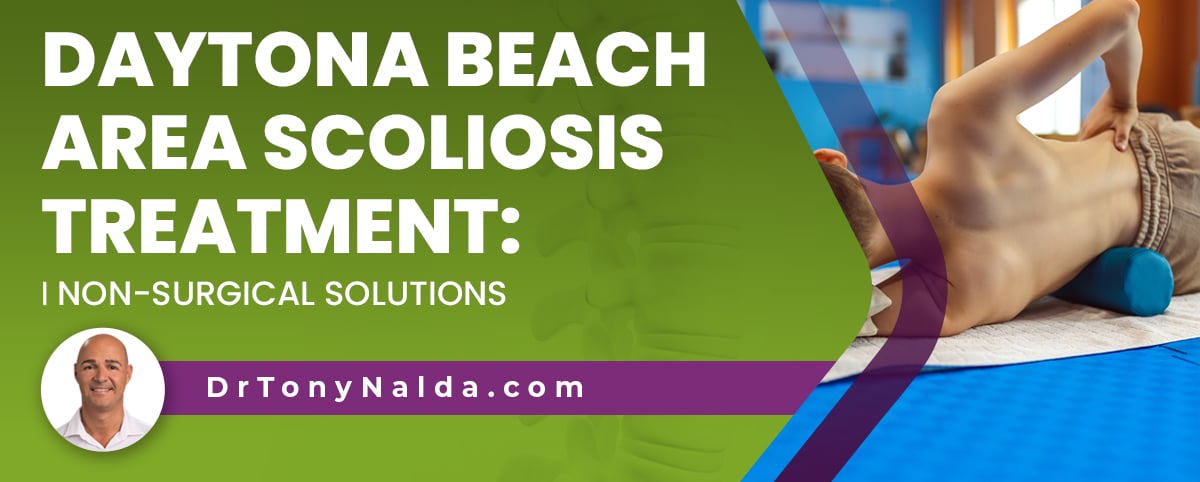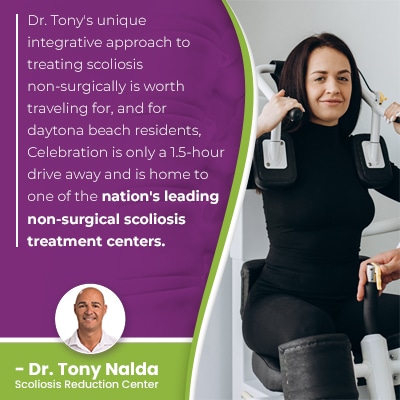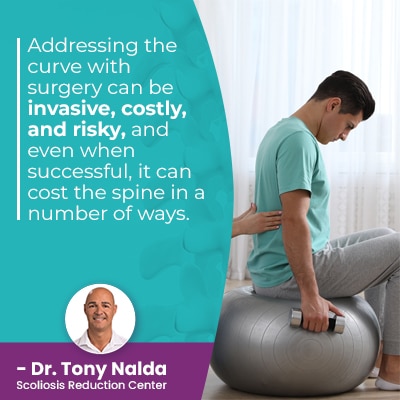Daytona Beach Area Scoliosis Treatment: Non-Surgical Solutions

Scoliosis can be treated with or without surgery, and the decision of which approach to choose can have far-reaching effects. Non-surgical treatment has a number of benefits that invasive surgery can't offer, and spinal surgery also comes with a number of serious potential risks, side effects, and complications.
Daytona beach area scoliosis treatment can include Celebration, Orlando's Scoliosis Reduction Center® with a 1.5 hour drive. Dr. Tony Nalda's non-surgical scoliosis treatment center's results speak for themselves and prove that many cases of scoliosis don't require surgical treatment.
Table of Contents
Scoliosis: Understanding a Complex Condition
Scoliosis is often described as a complex condition to treat and there are a number of reasons for this.
Scoliosis causes an unnatural spinal curve to develop, but it also involves a rotational component, making the spine twist unnaturally.
Scoliosis is a structural spinal condition, so its underlying structural nature has to be impacted with treatment.
Scoliosis is also progressive, meaning its nature is to get worse over time, and this is a significant challenge when treating scoliosis in children because it's growth that triggers progression; a focus of treatment has to be on counteracting the condition's progressive nature, despite the constant trigger of growth occurring.
What's most important to understand about scoliosis is how all types and severity levels can benefit from treatment, and as a progressive condition, sometimes when treatment is started is as important as the type of treatment.
Scoliosis is also complex to treat because there are so many different types and severity levels that necessitate the complete customization of effective treatment plans.
Idiopathic Scoliosis
Idiopathic scoliosis is the most common type to affect all ages, and idiopathic means not clearly associated with a single-known cause.
While the cause of idiopathic scoliosis is unknown, we do know how to treat it effectively, and the most prevalent type of scoliosis overall is adolescent idiopathic scoliosis diagnosed between the ages of 10 and 18.
Idiopathic scoliosis is thought to be multifactorial: caused by a number of factors, or a combination of factors, that can vary from person to person.
Idiopathic scoliosis accounts for approximately 80 percent of known diagnosed cases, and the remaining 20 percent are associated with known causes that are neuromuscular, degenerative, or congenital.
Different types of scoliosis have different characteristics and treatment needs that further complicate the treatment process.
Here at the Scoliosis Reduction Center®, I have treated every type and severity level of scoliosis and can customize treatment plans accordingly; my multi-faceted treatment approach that involves being trained and certified in multiple different treatment modalities allows me not only to customize treatment plans, but to be able to adjust them accordingly based on how spines are responding to treatment and/or growth.
Atypical Scoliosis Types
 Treating atypical types of scoliosis is particularly complex, and a condition's cause has to be the focus of treatment.
Treating atypical types of scoliosis is particularly complex, and a condition's cause has to be the focus of treatment.
In typical cases of idiopathic scoliosis, curves bend to the right, away from the heart, but in atypical condition types, curves can be left-bending and more complex to treat.
Neuromuscular scoliosis cases, for example, are often among my most difficult patients to treat because the scoliosis was caused by the presence of larger neuromuscular conditions such as spina bifida, muscular dystrophy, or cerebral palsy.
The underlying neuromuscular condition has to be the driving force of treatment, so this complicates the process.
Degenerative scoliosis is caused by a combination of natural age-related spinal degeneration and the cumulative effect of certain lifestyle factors; this type affects older adults and is more prevalent in females than males.
Congenital scoliosis affects babies born with the condition as it's caused by a malformed spine that develops in utero; this is a rare type affecting approximately 1 in 10,000.
So as you can see, no two cases of scoliosis will be the same and require identical treatment plans, and here at the Center, an integrative treatment approach means that multiple different types of treatment are combined to impact conditions on every level.
Conservative Non-Surgical Scoliosis Treatment
There was a time when surgery was the dominant choice for scoliosis treatment, but we have since learned that particularly when treated proactively, many cases of scoliosis don't require surgery.
We also know that scoliosis surgery commonly involves fusing the spine, and this can cost the spine in terms of its strength and function, while non-surgical scoliosis treatment works towards preserving as much of the spine's natural strength and function as possible.
Dr. Tony's unique integrative approach to treating scoliosis non-surgically is worth traveling for, and for daytona beach residents, Celebration is only a 1.5-hour drive away and is home to one of the nation's leading non-surgical scoliosis treatment centers.
What the Center offers is a fully-customized treatment approach that addresses the specifics of each patient's body type, curvature type, experienced symptoms, and treatment goals.
Through combining physical therapy, scoliosis exercises, chiropractic care, corrective bracing, and rehabilitation, and when these different facets of treatment are applied proactively, they can work together and complement one another.
Reducing the Curve Without Surgery
Chiropractic care can involve a number of techniques and manual adjustments that can work towards repositioning the curve's most-tilted vertebrae back into alignment with the rest of the spine; this is a curvature reduction and is impacting the structure of the spine.
Physical therapy and scoliosis exercises can work together to increase core muscle strength for more support and stability for the spine, to increase spinal flexibility and make it more responsive to treatment, to improve posture, and address any related muscular imbalance.
As the leading spinal condition among school-aged children, and as progression is triggered by growth, childhood scoliosis should always be taken seriously, and as growing spines are more malleable, bracing is a regular facet of childhood scoliosis treatment.
As a progressive condition, scoliosis treatment is about managing an ongoing condition for the best quality of life.
Addressing the Curve With Surgery
 Addressing the curve with surgery can be invasive, costly, and risky, and even when successful, it can cost the spine in a number of ways.
Addressing the curve with surgery can be invasive, costly, and risky, and even when successful, it can cost the spine in a number of ways.
Scoliosis surgery is a type of spinal fusion that involves fusing the curve's most-tilted vertebrae into one solid bone and attaching metal rods to the spine to hold it in place, and while this can straighten a bent spine, the approach is contrary to the spine's natural movement-based design.
A spine that's fused is also weaker and more vulnerable to injury, and some patients experience an increase in back pain, particularly around the fusion site and as a result of increasing spinal rigidity.
Spinal fusion addresses the spine and the spine alone, but the condition's effects extend beyond the spine, to its surroundings also; conservative non-surgical scoliosis treatment addresses all of the condition's effects, including how it impacts the spine's surrounding muscles and nerves.
Addressing the curve with surgery means a reactive approach because traditional surgical treatment doesn't have a strategy for addressing scoliosis while mild, when it's most treatable, so commonly recommends watching and waiting for progression.
When/if a patient progresses into the severe classification, spinal fusion can be recommended, but had treatment been proactive and started earlier, progression might have been preventable.
The more scoliosis progresses, the more complex it can be to treat, hence the benefit of starting treatment as close to the time of diagnosis as possible.
Conclusion
Daytona beach area scoliosis treatment can include Dr. Tony's Scoliosis Reduction Center® with a 1.5-hour drive to Celebration.
There are never treatment guarantees, but with early detection and intervention, there are fewer limits to what can be achieved with non-surgical treatment, so knowing the condition's early signs can help lead to early detection.
Scoliosis ranges widely in severity from mild scoliosis to moderate scoliosis, severe and very severe scoliosis, and the more severe, the more likely continued progression is.
In adults, the main scoliosis symptom is pain, and in children, the main scoliosis symptoms involve postural changes such as uneven shoulders and uneven hips.
While a surgical response to scoliosis still has its place in scoliosis treatment, particularly in severe and/or atypical cases, conservative treatment offers an alternative.
The risks of spinal fusion surgery are real so should be considered carefully, and for those wanting to forgo a surgical recommendation, or try a less-invasive and more-natural treatment approach first, the Center's integrative approach can be worth traveling for.
Once a patient of the Center, access to multiple scoliosis-specific treatment disciplines are accessible under one roof.
For those looking for guidance, support, and/or non-surgical scoliosis treatment, don't hesitate to reach out for a consultation.
Dr. Tony Nalda
DOCTOR OF CHIROPRACTIC
After receiving an undergraduate degree in psychology and his Doctorate of Chiropractic from Life University, Dr. Nalda settled in Celebration, Florida and proceeded to build one of Central Florida’s most successful chiropractic clinics.
His experience with patients suffering from scoliosis, and the confusion and frustration they faced, led him to seek a specialty in scoliosis care. In 2006 he completed his Intensive Care Certification from CLEAR Institute, a leading scoliosis educational and certification center.
About Dr. Tony Nalda
 Ready to explore scoliosis treatment? Contact Us Now
Ready to explore scoliosis treatment? Contact Us Now





